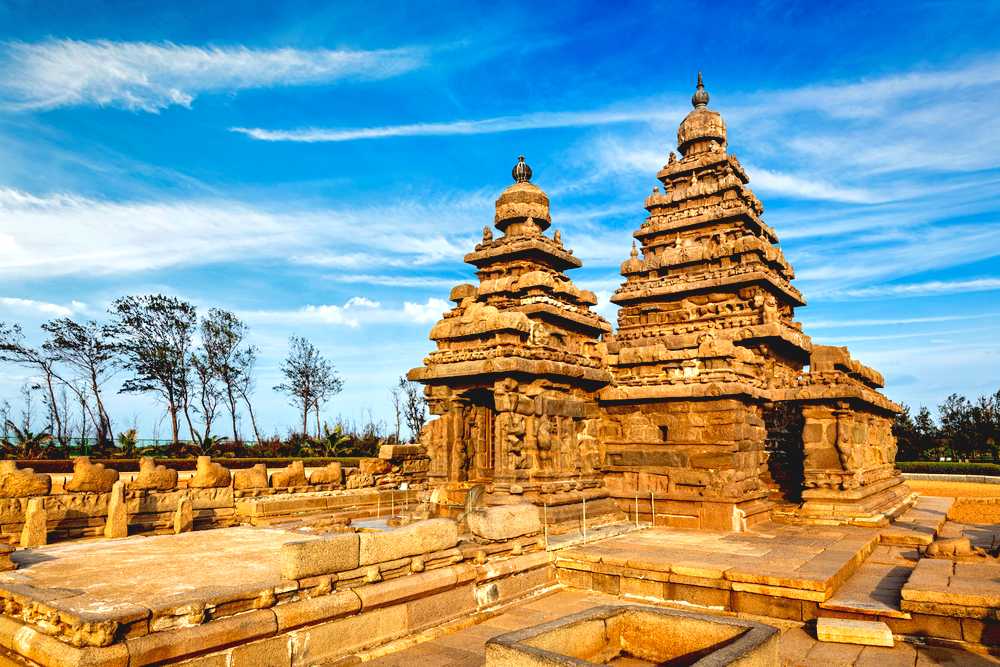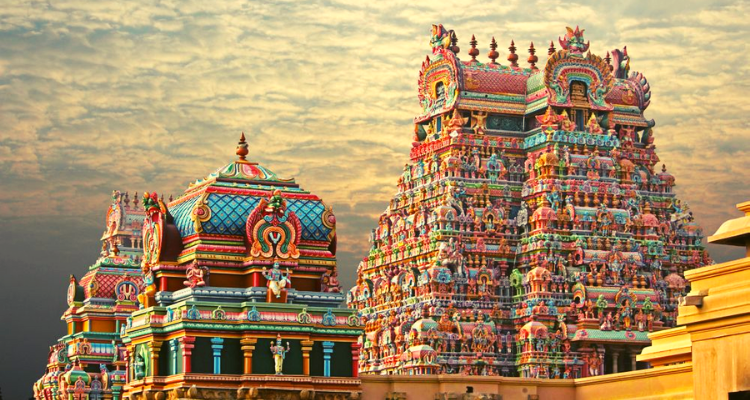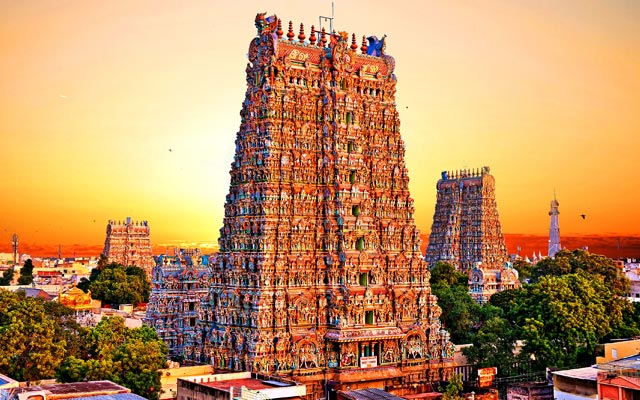


Chennai - Kanchipuram - Mahabalipuram -Chennai - Pondicherry -Tanjore - Trichy - Madurai - Kanya Kumari - Kovalam - Periyar - Kumarakom - Alleppey - Cochin - Ooty - Mysore - Hassan - Bangalore - Mumbai
South India is peninsular region bounded by the the three waters. Its Southern-most edge in Tamil Nadu (Kanyakumari) is the meeting point of three waters (Indian Occean, Arabian Sea and Bay of Bengal). So it has many a top ranking spots for backwaters cruise
It lies between hills of Eastern Ghats and Western Ghats. So it has has hill stations developed by the British during their colonial rule to evade the summer heat of India. It is also separated from rest of India by a river in its North. So the South Indian culture and architecture stands in contrast to Northern part of India.
It is a cradle of art and culture for the reason that South India has been ruled by various native dynasties since times immemorial till its colonization in modern era. The kings being native were steeped in the local culture and ethos. Temple architecture in South India with its various forms developed to its perfection unlike in other parts of India.
On Arrival at Madras Airport by international flight, assistance will
be provided to receive the guests and to transport to the Hotel for
comfortable overnight stay.
Check-in time in hotels is 12 Noon.
From the morning itself, the exploration of the Chennai will start.
Chennai, the capital city of Tamil Nadu, is called the 'Gateway to
the South'. Since the Peninsular Southern region is the cradle of old
Indian culture, it would be appropriate to start the South tour with
acquaintance to its culture at the gate way of South.
So tour begins with the visit to its cultural centre Kalakshetra. It houses school of art and music. Here you can learn about the nuances of class dance form of South India called Bharatnatyam and classical Carnatic music, distict from the Hindustani classical music of North India.
You
will also explore traditional weaving and designing. Besides, you
can interact with the performing artists and the artisans at work.
Next to follow are historical monuments. Visit to Fort St. George
built in 1653, which now houses the Secretariat and Legislative
Assembly of Tamil Nadu, will give you an opportunity to explore the
Indo-British architecture.
Places next to visit are St. Mary's
Church, the oldest Anglican Church in India and Shri Parthasarathy
Temple built by Pallavas in the 8th century AD. Other places to visit
include Kapaliswara Temple, Mylapore( eighth century Pallava Temple
dedicated to Lord Shiva), San Thomas Cathedral Basilica rebuilt in 1606
as a cathedral and made a basilica in 1896 and Theosophical Society
Centre ( the world headquarters of the Theosophical Society) - a
spiritual body formed with the objective to synthesize all religious
teachings in harmony with philosophy and science.
Back to Hotel, have lunch and take a nap after hectic tour and then
roam around leisurely of your own before you go to sound sleep.
Enjoying the morning drive to Kanchipuram, you reach one of the seven sacred cities of Hindus. This is Kanchi, a city of thousand temples. Kanchi (now called Kanchipuram) was the capital of the early Cholas dynasty during the 2nd century BC.
Kanchi was a major seat of
Tamil learning besides an important place of pilgrimage for all the
major religions in India -Buddhists, Jains and Hindus. In addition to
the monumental beauty of its temples, the city is also known for its
silk weavers who settled here four centuries back to make Kanchipuram a
famous Indian city for production and trading of silk fabric.
Indian Then you proceed to Mahabalipuram, 70 kms from Kanchipuram,
enjoying the enchanting driveway south of Madras leading to
coast-line where Mamallapuram (Mahabalipuram) is located to explore the
relics of the ancient-most port of and ruins of city besides the
monumental remains of ancient Pallavas dynastic rulers.
Then you proceed to Mahabalipuram, 70 kms from Kanchipuram,
enjoying the enchanting driveway south of Madras leading to
coast-line where Mamallapuram (Mahabalipuram) is located to explore the
relics of the ancient-most port of and ruins of city besides the
monumental remains of ancient Pallavas dynastic rulers.
The Pallavas
created many marvelous monuments with sculptural panels, caves,
rock-cut temples and Rathas(Chariots).
Krishna Mandapam (open space enclosed within high walls) with the
world's largest bas relief measuring 27m x 9m, whale- back shaped rock
with cut-out figures of gods, demi-gods, men .beasts, birds etc. Shore
Temple, one of the oldest in south dating back to 8th century AD is a
good example of the first phase of structural temples constructed in
Dravidian style.
The Five Rathas, a group of five monolithic temples, each created in different Dravidian architectural styles.
Back to Chennai for overnight at the hotel.
Pondicherry, once a French Colony, affords you an opportunity to get transported to a different socio-cultural milieu since most of the Indian territory remained under British empire.
You can readily mark the French influence on the life style and the monumental structures in Pondicherry. Pondicherry's main places to visit are the Rai Nivas, the Sacred Heart Church and the Sri Aurobindo Ashram.
Aurobindo Ashram was founded in 1926 by Sri Aurobindo, a famous spiritual master of India. After his death, the spiritual authority passed to one of his disciples, a French woman known as the Mother.
The Mother established another Ashram Retreat called city of Dawn Auroville, 10 km from Pondicherry with an objective to create a city of the future where people from India and abroad could live and work together in a commune steeped in spiritual environment.
Check-in at the hotel in Pondicherry for overnight stay.
Morning drive to Tanjore at a distance of 175 km from Pondicherry
includes en-route visit temple of Lord Natraja at Chidambram. On
arrival at Tanjore, check-in at the hotel where you can fresh up and
dine before exploring Tanjore in the afternoon.
Tanjore is a city of art and music. It is a cultural centre for
Carnatic music and dance. It is also a city of craftsmen engaged in
producing traditional musical instruments and handicrafts.
Tanjore (Thanjavur) is known for its famous Brahadeeswarar Temple. The temple was got constructed by the Chola King Raja Rajan a millennium back. Other attractions of Tanjore are Art Gallery and the Saraswathi Mahal Library.
Night stay at Tanjore Hotel.
After a morning drive covering 201 km Drive to Trichy. Just 5 kms further drive from Trichy lands you on an island called Srirangam. Surrounded by the Kaveri water, Srirangam is a 600 acre island town. Here stands Sri Ranganathaswami temple enclosed within the seven walls.
This temple has 22 gopurams
(gate-ways with pyramid-like structures). One of these is highest in
India. It is 72 m high 13 tiered structure which catches the eyes
from miles around.
Another attraction here is The Rock Fort
situated on the banks of River Kaveri. The Fort stands on an 84 m
high rock which is one of the oldest rocks in the world (approximately
3,800 million years old). Yet more that the fort, what attracts the
visitors most is the temple atop the rock. To reach the temple, you
have to climb 344 rock-cut steps.
In the temple, you will explore the inscriptions dating back 3rd century B.C.
The day ends with a drive to Madurai to check-in at the hotel for overnight stay.
The day starts with morning sightseeing tour of Madurai, known as Athens of the East. Second largest city on the banks of the River Vigai, Madurai is at least 2500 years old city. It may be still older as a mythological tale tells.
The city is named after nectar (Mathuram) that fell from Shiva's locks when he came to bless its people for constructing a temple for him. Madurai is famous for its Meenakshi-Sundareswara Temple.
Of its 12 gopurams, the tallest four stand at the outer walls of the temple. The 48.8 m high southern gopuram contains over 1500 sculptures. In the Ashta Shakti Mandapam inside the Meenakshi temple, the sculpted pillars tell the story of the beautiful princess of Madurai and her marriage to Lord Shiva.
Afternoon at leisure followed by overnight stay at the hotel.
The day starts with morning drive from Madurai to Kanya Kumari covering 352 km in 5 hours. 45 km short during the drive to Kanya Kumari, Padmanabhapuram lays en-route. This was the capital of erstwhile Travancore State until 1333. Padmanabhapuram is known for its monumental relics including fort, a palace and a temple.
The palace has some important art relics while the Ramaswamy
temple has exquisitely carved panels depicting scenes from the
Ramayana. Visit to Kanya Kumari takes place in the afternoon.
Kanya Kumari is located at the
southernmost end of Tamil Nadu (and India too) at the point where the
three seas meet - the Bay of Bengal, The Arabian Sea and the Indian
Ocean. It locates Kumariamman temple dedicated
to the virgin goddess Kanyakumari (Parvati).
The temple is built at the spot where the goddess is believed to have waited for Lord Siva to meet. Other places to visit here are Gandhi Memorial erected at a spot where the ashes of Mahatma Gandhi were kept for public view in an urn before being immersed into the three seas and Vivekanand Memorial built on the Vivekananda Rock where the great Indian sage Swami Vivekananda went into meditated.
The day ends with the drive to Kovalam and reaching there for a overnight stay in a hotel.
The Day is spent on the Kovlam Beach at leisure and night in the hotel
The day starts with morning drive to Periyar and check-in at the hotel on arrival there.
Periyar
is wildlife sanctuary with a habitat of about 35 tigers and leopards.
Spread over an area of 777 sq km, the sanctuary locates within it a 26
sq km artificial lake which serves as natural habitat of sambars,
wild boars, elephants and antelopes which can also be seen on the banks
of the river during a boat cruise. Periyar has superb natural
surroundings with tea, coffee, pepper and cardamom plantations besides
the lush green forests.
Afternoon
Boat cruise on the Lake Periyar to view the wildlife around followed by overnight stay at the hotel.
After 136 km Drive to Kumarakom where comfortable stay on deluxe
Houseboat awaits you combined with the relaxing sightseeing of
backwater cruise.
Embark Kerala Houseboat "Kettuvalam" at Kumarakom
and journey towards Munnattumugham village and then to Champakulam(
earlier called Kalloorkad) which is an ancient trade centre of
backwaters.
Deboard the houseboat and visit St. Mary’s Florence Church said to have been blessed by St. Francis in 42 AD. The mural paintings in vegetable oil in this Church are unique. Visit also the famous Champakulam snake boat construction yard.
Check in the hotel for night stay at Champakulam village.
Leave Champakulum on cruise towards Alleppey finishing point jetty followed
drive to Cochin.
Check in the hotel at Cochin and relax for a day and stay overnight to take up the hectic tour of Cochin the next morning.
After breakfast in the morning, start exploring Cochin.
Cochin(Kochi) , gateway to Kerala, has a fine natural harbour. Places to visit in Cochin Mattanchery Palace, St. Francis Church, Wellington Island, Bolghatty Island, and Jewish Synagogue. Then Cruise through the back-waters to get the glimpses of the rural life and view the harbour and three islands.
Relax in the afternoon after lunch. Spend the evening enjoying the Kathakali Dance Show in an auditorium.
Reaching Ooty from Cochin involves 280 km drive. Since Ooty is located at the highest of Nilgiri Hills, the travel through the winding hilly roads takes enough time.
At the same time, the picturesque scenic beauty around the winding green hill forests makes the travel itself sightseeing.
On reaching Ooty, check in the hotel, relax and have a
sound sleep to be ready for the tour the next morning.
Located at the high plateau hills at 2240m above sea level at the junction of the Eastern and Western Ghats, Ooty is the headquarters of the Nilgris district. Fields in step-farming with coffee and tea plantations amidst the hill forests with trees like confiers, eucalyptus, pine and the wattle makes Ooty a superb place of natural beauty.
The places to visit in Ooty are Botanical Gardens,
the artificial lake and Dodabetta Peak which is the highest point in
the district at a height of 2623m. In Botanical Garden, "summer
Festival" is held annually during the month of May.
17 km from Ooty , there is another equally famous South Indian Hill Station - Conoor.
It is a small town with a pleasant climate round the year. Annual
Tea and Tourism Festival is held here during Dec-Jan.
The chief attraction of Conoor is the Sim's Park. It is well maintained botanical garden with several varieties of rare plants, not to be found in other hill stations.
After 155 km drive Ooty, reach Mysore and check in at the hotel.
Sightseeing tour of Mysore starts in the afternoon.
770 m above sea level, Mysore was the erstwhile capital of the Wodeyars’ dynastic rulers. Mysore is named after the legendary demon-king Mahishasur who was killed by the mythological goddess Chamundeshwari. Mysore attracts tourists for its imposing Royal Palace with a Durbar Hall where the the then Maharaja's jewellery, studded gold throne (weighing 200 kgs) is on display dring Dussehra Festival.
The main tourist attraction of Mysore is it two millennium old Chamundeshwari temple on a hilltop as well as Nandi Bull half way to the temple. Nandi Bull is a rock-cut 4.8 metre sculture. 19 km north-west of Mysore, you visit KRS Dam and the ornamental Brindavan Gardens with musical fountains and colourful lights
Just 45 km drive from Mysore transports you to Somnathpur temple in the morning.
This temple, built in 1268 AD in Hoysala architectural style, is located at a star shaped chiseled plinth base.
Many sculptured miniature elephants around the temple are monumental . The temple wall depicts scenes from Ramayana, Mahabharta and Bhagvata.
Spend afternoon at leisure followed by overnight stay at the hotel.
After 150 km drive from Mysore, reach Hassan and check-in at the hotel
to undertake visit of Belur and Halebid in the afternoon.
Belur temple took over 103 years to be
built in the best of Hoysala style of architecture. The temple is
raised on a star shaped rock-cut plinth. From the base upwards, there
are fine decorative intricate carvings. 650 sculptured elephants stand
in a row outside the shrine
Many of the figures of full blossomed
women depicted at Belur are believed to be portraits of King
Vishnuvardhana's queen.
Halebid, 16 km east of Belur and 27 km from Hassan, locates Hoysaleswara Temple
dating back to 12th century, is a sculptural bonanza. The walls of the
temple are replete with carvings of various gods and goddesses, animals
and birds besides dancing girls.
The temple dedicated to Lord Shiva guarded by a Nandi Bull remained in completed even after 86 years in the process of construction. In the inner sanctum, the star black Shiva lingam is worshipped till date. The ornate carving at the temple door is marvelous.
During drive form Hassan to Bangalore, Sravanbelgola falls en-route.
Sravanbelgola is known for
the world's tallest monolithic statue(17 metre high) of Bahubali
(Gomateshvara). The statue was built in 981 AD by the sculptor
Aristanmi. This is sacred monument for the Jain, an Indian religious
sect. Sightseeing tour resumes on arrival at the Bangalore city.
Bangalore, the capital city of Karnataka,
is centre of science, aeronautics and electronics. Situated 1000 m
above sea level, Bangalore is called the garden city. Weather is
pleasant round the year. The places to visit here include Lalbagh (the
finest botanical Gardens of India), Cubbon Park covering 300 acres of
land and Vidhana Soudha housing The State Legislature and Secretariat
are the main attractions.
Late evening drive to airport for flight to Mumbai.
On arrival, check in at the hotel in Mumbai.
Mumbai (Bombay), capital city of Maharashtra State and commercial capital of India, is an ancient city. The Buddhist and Hindu dynasties ruled the region until the 13th century.
There were only scattered settlements on the island. The development of Bombay as a metropolitan city started with after the East India Company occupied Bombay. Gateway of India in Bombay was built to commemorate the royal visit of George V and Queen Mary in 1911.
Most of the other
monumental structures here came up during British empire. The places to
visit here include Prince of Wales Museum, Flora Fountain, Victoria
Terminus, St. Thomas Cathedral, Crawford Market, Malabar Hill, the
Hanging Gardens and Dhobi Ghat (Washermen's village).
Afternoon at leisure.
Departure from Mumbai with a drive to airport for flight to onward destination.